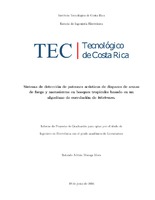Sistema de detección on de patrones acústicos de disparos de armas de fuego y motosierras en bosques tropicales basado en un algoritmo de correlación de bitstream.
Resumen
Costa Rica has a fourth of its national territory that corresponds to protected forest areas,
which area constantly foraged by poachers and illegal loggers. Determining where and whendoes an illegal act happen is a hard task to accomplish for the rangers given the big extensionof protected area.
This project proposes a proof of concept of an acoustic detector that indicates when does
an event of illegal hunting or logging happen. The solution proposed is based on a crosscorrelationalgorithm implemented in a FPGA. The design problem is partioned in two: adetection algorithm based on Signal Theory and a module devoted to data acquisition. Bothmodules are graphically implemented on LabVIEW and ported to a National InstrumentsmyRIO for their testing.
The _rst implemented module consists of a binary detector of acoustics patterns, based oan adaptive threshold comparator, from which a ROC (Receiver Operator Characteristic)
curve can be obtained. This type of curves plots the sensibility of a binary detector. The
input signal to this detector is pre-preocessed with a particular algorithm to enhance the detectability of the signal. In this case, a cross-correlation processing is used. Since the FPGA porting of this algorithm is being developed in a parallel project, a high level implementation is used as reference model.
The second module developed in this project is the data acquisition stage. Here a sigmadeltamodulator must be emulated, and then it will be substituted by a real circuit. Thiswill provide the necessary data for the cross-correlation algorithm.
Descripción
Proyecto de Graduación (Licenciatura en Ingeniería Electrónica) Instituto Tecnológico de Costa Rica, Escuela de Ingeniería Electrónica, 2016.


